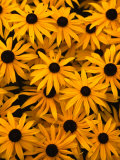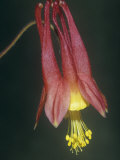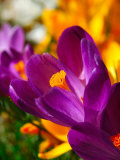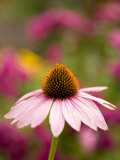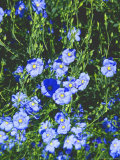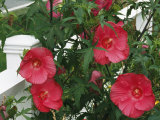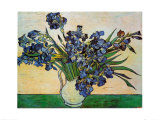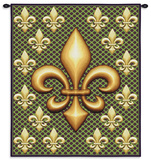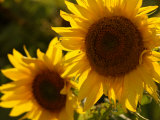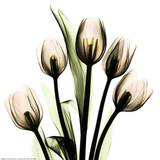|
|
| Asteraceae is the second largest family of flowering plants and includes asters, chicory, daisies, dandelions, sunflowers, thistles (artichoke), most common in temperate regions and mountaineous tropics. |
|
|
Black Eyed Susans (Rudbeckia hirta) are part of the Asteraceae family.
Black Eyed Susans are the state flower of Maryland.
|
|
|
|
|
|
|
Columbine, recognizable for their bell-shaped flowers which reminded people of a flock of doves, is a perennial plant. The name ‘columbine’ comes from columbarium which is a vault of niches for urns containing cremated ashes, and resembling a dovecote, or house for doves.
In the language of flowers ‘columbine’ means, or has meant, folly, resolution, anxiety, and infidelity; in church columbine designates the Holy Ghost, wisdom, understanding, counsel, fortitude, knowledge, piety, and fear of the Lord.
In the Commedia dell’Arte (a form of improvisational theatre), a stock character named Columbina has the role of the comic servant, often the only character with any intellectual oversight of the situation. In Ruggiero Leoncavallo opera Pagliacci, the character Nedda is a “Columbina”.
The blue columbine is the Colorado state flower.
• Columbine Seed Packets 
Columbine quotes
• “The turtle's voys (voice) is heard, my dove so sweet;/The winter's past, the rain's gone, and the sleet;/Come forth now with your two eye columbine! (eyes like doves) ... ”.~ Chaucer, The Marchantess Tale, 1386
• “Her goodly bosom lyke a strawberry bed, Her neck lyke to a bunch of Cullambynes. Her brest lyke lillyes, ere theyr leaues be shed, ...”. ~ Edmund Spenser, Sonnet 64
• “There's fennel for you and Columbines ...”. ~ Ophelia to Laertes about Hamlet’s rejection; William Shakespeare
• “I am a willow of the wilderness,/ Loving the wind that bent me, All my hurts/ My garden spade can heal. A woodland walk,/ A quest of river grapes, a mocking thrush,/ A wild rose or a rock-loving columbine/Salve my wounds.”. ~ Ralph Waldo Emerson
|
|
|
|
Crocus are hardy perennial flowering plants in the Iridaceae family. They grow from corms and are among the first flowers to bloom in the spring. The autumn blooming crocus, Crocus sativus, are the source of the dye (intense yellow), medicinal herb (mentioned by Hippocrates), and spice called saffron.
Saffron is the most expensive spice in the world: it takes an estimated 210,000 stigmas of a crocus bloom (at three per flower) to make one pound of saffron. And before chemical dyes the saffron color was reserved for royalty as well as being declared the official color of Buddhist robes. The word saffron comes from the Arabic za'faran.
The Greek word for crocus has it roots in “croci” which means the weft thread on the shuttle in weaving. In Greek mythology the gods Zeus & Hera loved each other so passionately that the land where they lived burst open with crocuses, and Ovid describes how the youth Crocus, who was in despair after witnessing the death of the nymphe Smilax, was transformed into this flower.
Crocus quotes
• “Hail to the King of Bethlehem,
Who weareth in his diadem
The yellow crocus for the gem
Of his authority!”. ~ Henry Wadsworth Longfellow, Christus
• “Iris all hues, roses, and jessamine/ Reared high their flourished heads between, and wrought/ Mosaic; underfoot the violet,/ Crocus, and hyacinth with rich inlay/ Broidered the ground, more coloured than with stone/ Of costliest emblem: Other creature here/ Beast, bird, insect, or worm durst enter none;/ Such was their awe of Man.”. ~ John Milton, Paradise Lost
|
|
|
|
The common species of Daisy, Bellis perennis, with its white petals and bright yellow center, is native to Europe and naturalized in North America. The name “daisy” may have evolved from “day's eye” because the head closes at night and opens in the morning.
In folk medicine daisies have astringent properties, and making daisy chains is a charming children's pastime.
• Daisy Seeds

Daisy quotes -
• “The daisy's for simplicity and unaffected air.” - Robert Burns, O Luve Will Venture In
• “The poet's darling.” - William Wordsworth, To the Daisy
|
|
|
|
Echinacea, also known as the Cone Flower, are in the Asteraceae family. They are drought tolerant perennials, some species are used as medicinal herbs.
• Echinacea Seeds

|
|
|
|
Flax, Linum usitatissimum, was first domesticated in the Fertile Cresent. The stem of the flax plant is grown for its fiber which is called linen, and seeds which are food for animals and humans and the source of linseed oil that has been used for centuries (paint, linoleum).
Evidence that flax, a symbol of “free and abundant vegetable life”, was important to early human culture is shown by its name being used to describe blonde hair, ie “her flaxen tresses”, and the word ‘linen’ generic for any household textile.
Reference to flax is found in the Bible (Joseph was clothed in linen, Rehad hid Hebrew spies in the flax spread on her roof, Jesus’ shroud), and the Egyptian mummy cloth of linen survived for 3,000 years.
Other fiber plants are jute, ramie, hemp, kenaf, nettles, coir, sisal, and cotton.
|
|
|
|
The Rose of Sharon is a hibiscus in the family Malvaceae (mallow).
Hibiscus are annual and perennial herbaceous flowering plants, native to warm temperate, subtropical and tropical regions throughout the world. Related plants are hollyhocks, okra, and cotton.
• Hibiscus: Hardy and Tropical Plants for the Garden
|
|
|
|
Iris are showy flowers, taking their name from the Greek mythology, Iris being the personification of rainbows and a messenger of the gods.
A stylized iris, a fleur-de-lis, is the symbol of France, Brussels, and Florence, Italy.
Iris quotes ~
• “In the Spring a livelier iris changes on the burnish'd dove; In the Spring a young man's fancy lightly turns to thoughts of love.” Alfred, Lord Tennyson
|
|
|
|
Papyrus, the plant used by the Egyptians to produce a thick paper like material, is a member of sedge family Cyperaceae.
Though resembling a grass, papyrus has ‘feather-duster’ flowering heads. Papyrus is mainly cultivated as an aquatic ornamental plant today.
• Papyrus (Egyptian Bookshelf)
|
|
|
|
Poppy can refer to any number of showy flowers, typically with one per stem, belonging to the poppy family.
Symbolically poppies have been used to represent both sleep and death, probably an association due to the Papaver somniferum being the source of opium and opiates. That symbolism is expressed in the World War I poem In Flander's Field (In Flanders Fields the poppies blow / between the crosses row on row ... ) and the tradition of artificial poppy flowers being worn in remembrance of dead.
Members of the poppy family also include the California state flower (Eschscholtzia californica) and the poppy flowers that provide the poppy seeds used in cooking and baking.
• Poppy Seeds
|
|
|
|
The term “sunflower” refers to annual or perennial plants native to the Americas, in the genus Helianthus, family Asteraceae.
Sunflowers have a large flowering head, made up of numerous florets packed closely together on stems that can grow to 9 ft (3 meters) tall.
Sunflower is the state flower of Kansas.
• Sunflower Seeds
• Sunflowers
|
|
|
|
Tulips, family Liliaceae, are perennial plants with large six petaled flowers growing from bulbs. They were introduced to the Netherlands in the 16th century from Turkey, though their origin is central Asia.
The name “tulip” seems to have evolved from the Persian word for turban, perhaps because the open bloom resembles a turban.
• Tulips: Species and Hybrids for the Gardener
• The Botany of Desire by Michael Pollan - Ch 2, Desire: Beauty/ Plant: The Tulip
|
|
|
|
Yarrow, Achillea millefolium, has numerous qualities beneficial to humans despite being associated with war in flower lore.
Its reputation as a healing plant was recorded by Homer in The Iliad: Achilles gave yarrow salve to his soldiers to help stop the bleeding, and in the Middle Ages a carpenter could staunch blood flow with the plant grown just outside the door.
The Yarrow also combats erosion as it prefers poorly developed soils and tolerates drought, as well as attracting beneficial insects.
In Chinese culture the yarrow stalks were used to throw the I Ching.
• The Herbalist of Yarrow: A Fairy Tale of Plant Wisdom
|
|
|
|
Orchidaceae
Caryophyllaceae, commonly called the 'Pink' or the 'Carnation'
1. Asteraceae or Compositae (daisy family): 23,600 species
2. Orchidaceae (orchid family): 21,950 species
3. Fabaceae or Leguminosae (pea family): 19,400
4. Rubiaceae (madder family): 13,183
5. Poaceae or Gramineae (grass family): 10,035
6. Lamiaceae or Labiatae (mint family): 7,173
7. Euphorbiaceae (spurge family): 5,735
8. Cyperaceae (sedge family): 4,350
9. Malvaceae (mallow family): 4,225
10. Araceae (aroid family): 4,025
for a thorough scientific discussion see
Missouri Botanical Gardens
Kew Gardens
|
|
|
previous page | top
science > botany > flower list > flowers 1 | FLOWER FACTS & TRIVIA | state flowers
flower lesson ideas | gardens ideas < social studies
|
|
I have searched the web for visual, text, and manipulative curriculum support materials - teaching posters, art prints, maps, charts, calendars, books and educational toys featuring famous people, places and events - to help teachers optimize their valuable time and budget.
Browsing the subject areas at NetPosterWorks.com is a learning experience where educators can plan context rich environments while comparing prices, special discounts, framing options and shipping from educational resources.
Thank you for starting your search for inspirational, motivational, and educational posters and learning materials at NetPosterWorks.com. If you need help please contact us.
|
|
|








